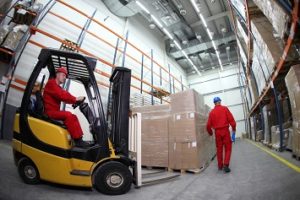In April, a 54-year-old worker at the Winnebago plant in Middlebury, Indiana, was struck and killed by a forklift. The worker, Ricky Schlabach, was 1 of about 70 workers who are likely to die in forklift accidents this year (71 workers were fatally injured by forklifts in 2015, according to the Bureau of Labor Statistics). A lot of those workers, like Schlabach, will be on the losing end of a forklift-pedestrian confrontation. What can you do to make sure that your workers are not among them?

endopack / iStock / Getty Images Plus / Getty Images
Here are some basic safety precautions for protecting pedestrians around forklifts.
Operator Training
Your forklift operators can be part of the solution—or part of the problem. Make sure they’re the former by training them to:
- Always look in the direction of forklift travel.
- Always yield the right-of-way to pedestrians.
- Always sound their horn at corners, doorways, aisles, and when they are backing up.
- Always warn workers on foot using their horn, lights, and hand signals.
- Never exceed the in-plant speed limit.
- Never leave a running forklift unattended.
Pedestrian Training
Pedestrians, too, can keep themselves safe by:
- Always steering clear. Forklifts cannot stop quickly; they are much heavier than they look. Workers should stay out of a forklift’s direction of travel.
- Always paying attention. It’s tempting to tune out the flashing lights and horns of forklifts, and the louder the workplace is, the more tempting it may be. But a worker’s awareness of forklifts could save his or her life.
- Always wearing their high-visibility clothing, if they have it.
- Never assuming that the forklift operator sees them. Unless pedestrians are certain that the forklift operator has seen them and will wait for them to cross, pedestrians should yield the right-of-way.
- Never lingering in a blind spot. Forklifts, like other vehicles, have blind spots, and workers should know where those blind spots are and avoid them.
Workplace Layout and Design
The layout of the workplace can help to prevent forklift-pedestrian accidents. For example:
- Separate travel lanes. Wherever possible, forklifts and pedestrians should have their own lanes for travel, and these should be separated by bollards or other substantial barriers.
- Smooth, dry surfaces. Broken concrete and wet surfaces can increase the possibility of a forklift tipping, and gravel or wet surfaces can increase the stopping distance.
- Lighting. Poor lighting and visibility make it more difficult for forklift operators and pedestrians to see each other.
- Mirrors. Mirrors can let both sides see what’s coming at a blind corner.
Forklift Maintenance
A forklift that is in poor condition is dangerous to the operator and to anyone else nearby. To protect pedestrians, do a preshift inspection to ensure that these components are in working order:
- Horn
- Backup beeper
- Lights
- Brakes
- Steering
